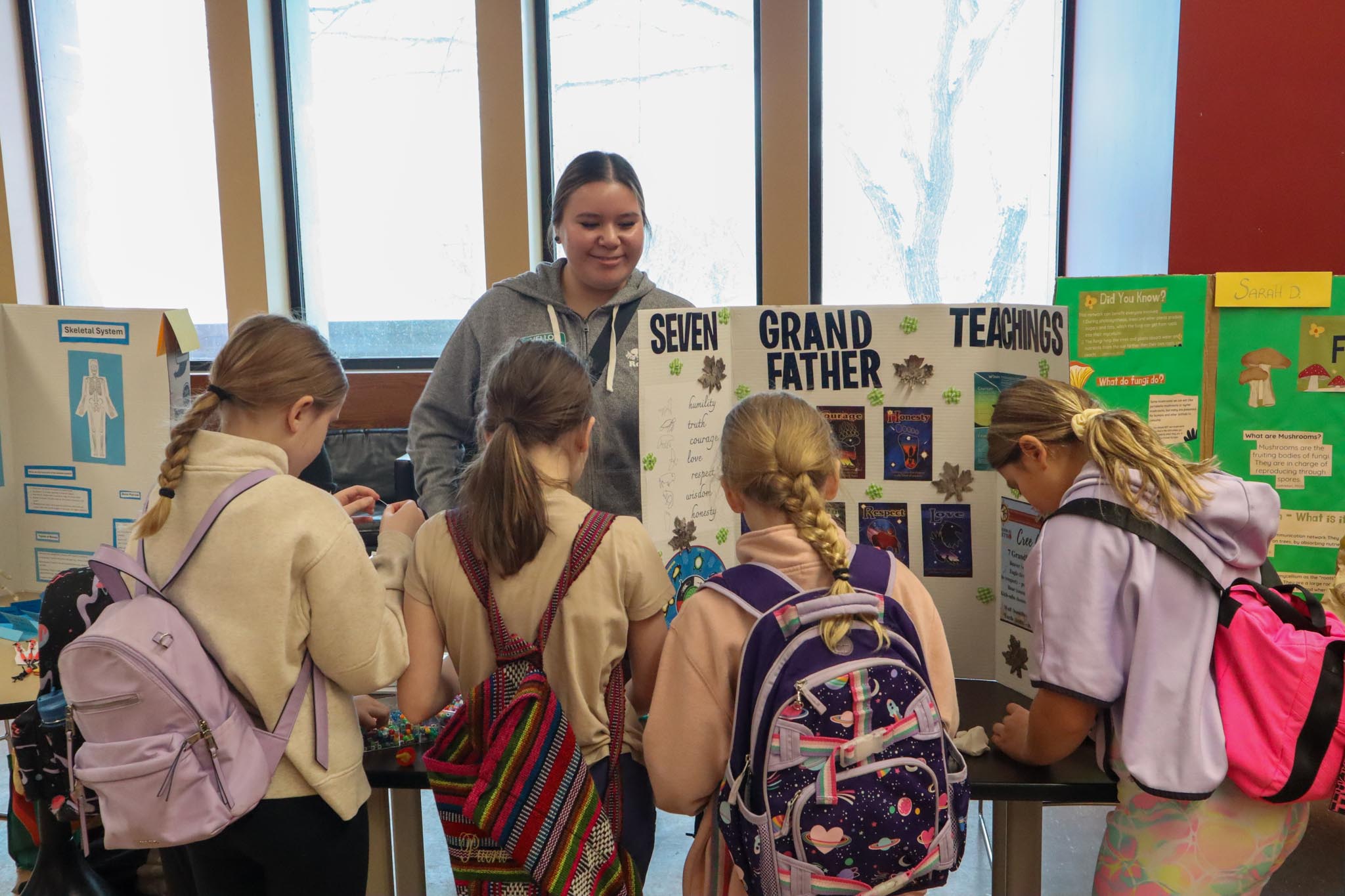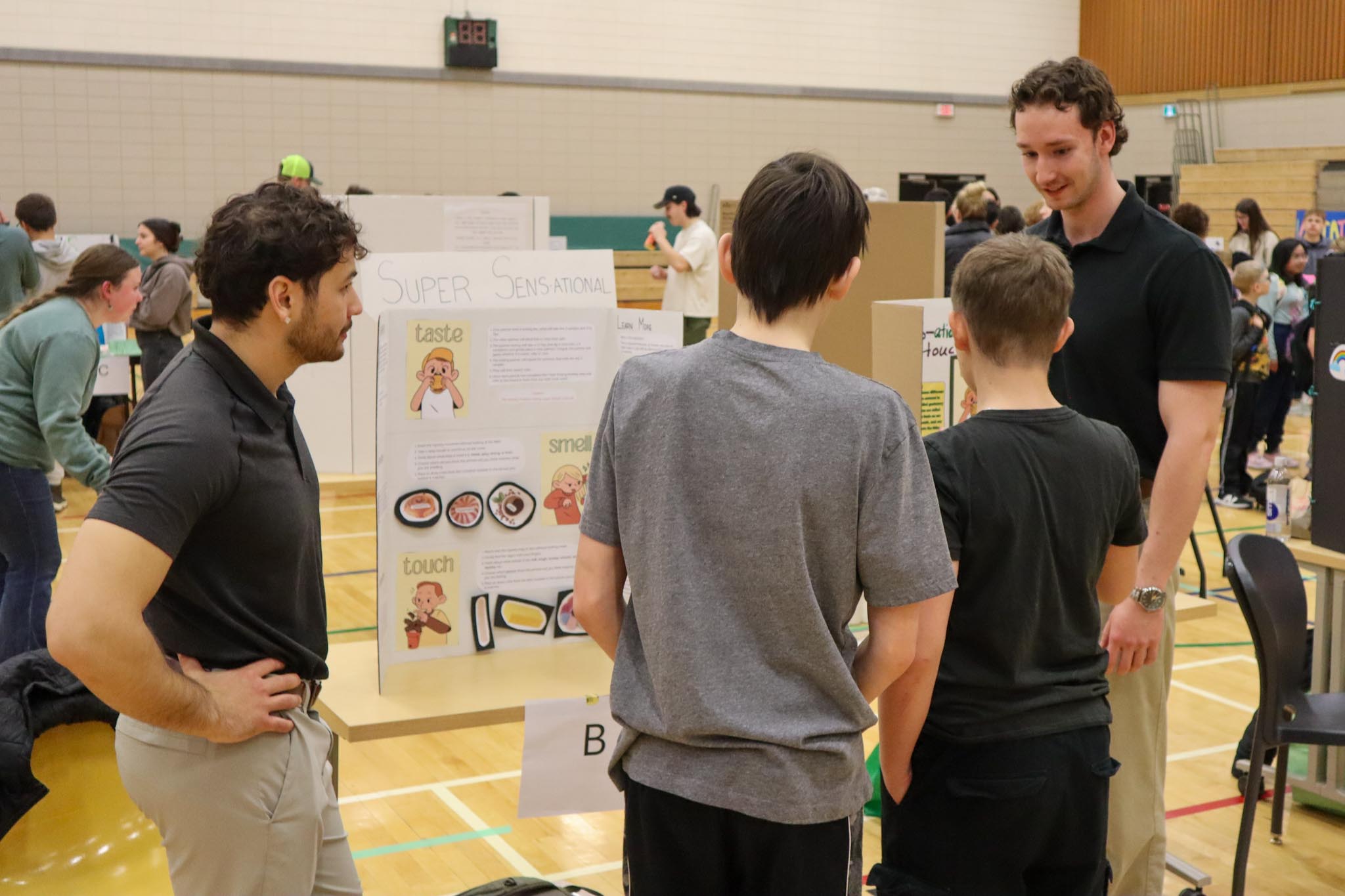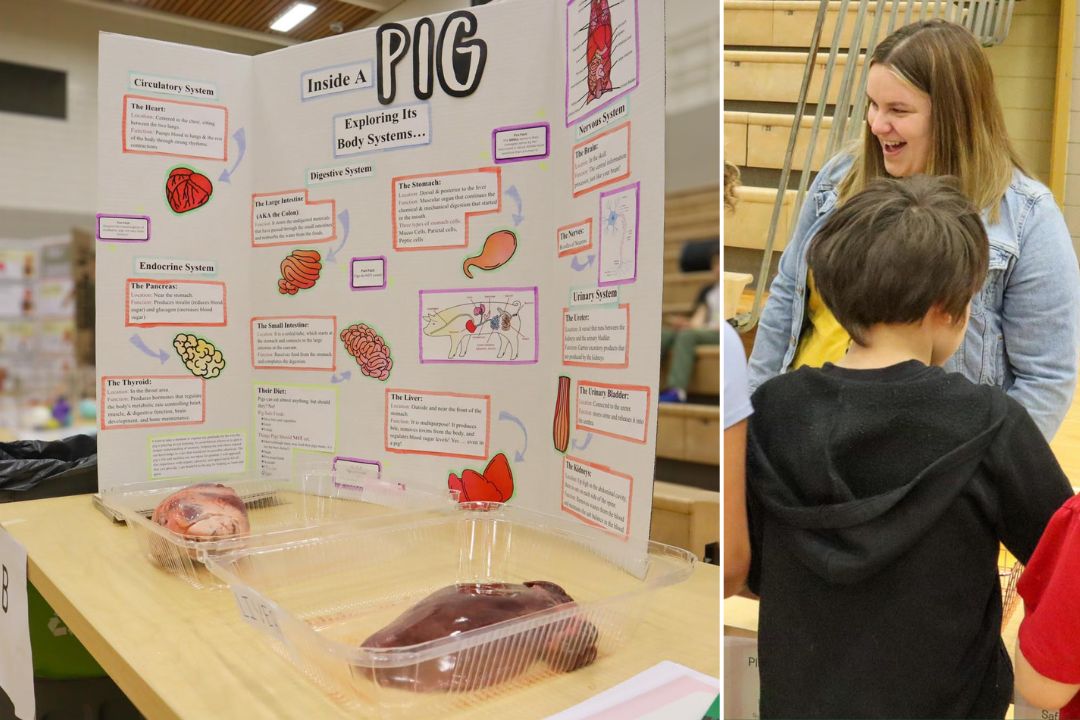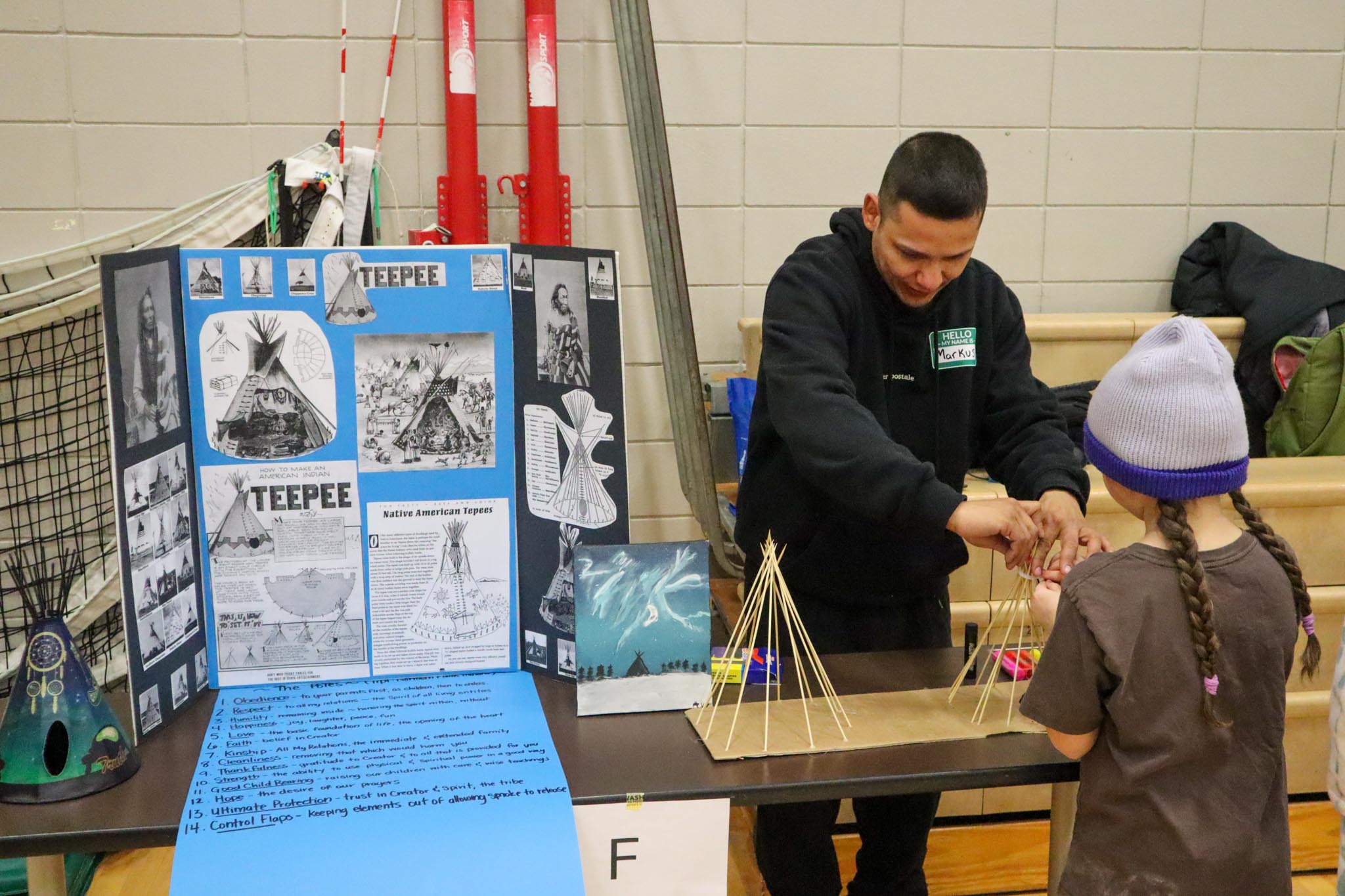
Future educators from USask inspire hundreds of elementary school students
More than 100 University of Saskatchewan (USask) College of Education pre-service teachers welcomed over 200 children to campus on March 28 for the Science and Human Psychology Inquiry Fair.
By Connor JayThe inquiry fair, organized and supported by the College of Education’s Dean’s Office and the Department of Curriculum Studies, was a cross-program collaborative event with pre-service teachers tasked to design several engaging activities for elementary-aged students to explore a variety of concepts related to science and human psychology.
Students ranging from grades three to eight from École St. Matthew School, St. Dominic School, and St. Michael Community School (Greater Saskatoon Catholic Schools) were invited to test out the work of pre-service teachers. The fair allowed pre-service teachers to lead experiential activities and offered valuable hands-on learning for elementary school students.
“When kids collide with your activities, there’s a completely different level of authenticity and honesty that tends to come out,” said Dan Krause, lecturer in Curriculum Studies and co-lead on the inquiry fair. “Kids will come and interact with your activity if they are interested and it will be very obvious if they’re not. I think it’s important [for pre-service teachers] to be able to reflect on how your activity is received by students.”
Krause collaborated with Dr. Tim Molnar (PhD), associate professor in Curriculum Studies, in early January to co-ordinate the logistics of the inquiry fair. Krause, Molnar and sessional lecturer Geraldine Stolar also needed to align the structure of their Curriculum Studies (ECUR) 322 and Educational Psychology and Special Education (EPSE) 202 sections for appropriate assessments and to provide enough support to their pre-service teachers. Through constant communication, planning, and check-ins with all involved, all three were confident the fair would be successful.
“Tim, Geraldine, and I placed general constraints on the projects in an effort to guide, but not prescribe, what the pre-service teachers would need to do. Students brought forward an idea in a proposal early in the term, and we would pose questions to the students about things to clarify and consider as they imagined what the vision of the event was."
Krause understood the fair would take a concerted effort and co-operation from internal and external members for it to be an enjoyable event for all.
“We wanted this to be a good experience for the pre-service teachers in the college and for the kids that are coming from the schools. Lots of people, both within the college and from the participating schools came together to make the event happen. We had facilities support, administrators, pre-service teacher volunteers, department funding, participating teachers, parent volunteers, and of course, the pre-service teachers creating the activities for the participating students.
“I think the pre-service teachers learned a lot about what it takes to bring something like this event to fruition, and hope that we [faculty and staff in the college] set a good example for them as they transition to practicing teachers.”
Once buses arrived and students started to engage with the presentations, Krause, Molnar and Stolar were able to see how the preparation turned into implementation. They each roamed the venue to see how the pre-service teachers interacted with the students and teachers.
“The pre-service teachers really delivered. I watched multiple instances where the pre-service teachers were talking with the practicing teachers,” said Krause. “The teachers in the field were taking pictures of the learning centres and the ideas that the pre-service teachers had brought forward.
"The feedback from participating administrators, elementary students, and participating teachers was positive, and I think that’s a testament to how hard the pre-service teachers worked on their activities, all the thought and planning that goes into it. Tim, Geri, and I placed a lot of trust in the pre-service teachers to deliver this event to the elementary students within the vision.”
Four third-year pre-service teachers were interviewed about their projects and how they found the inquiry fair experience.
Zander Antochow and Shaad Salido – Super Sens-ational

“We originally had a different idea involving kinesthetics, however, we weren’t able to do that. So, we had two days to come up with a senses activity,” said Antochow.
“We focused on three of the five senses,” said Salido. “We had the students interact with three different testing objects and they were to identify what they were touching, smelling or tasting.”
“The activities were catered towards the younger years, but it’s always a good refresher for the older students to understand exactly how those human body systems are working,” said Antochow. “Overall, the experience was fantastic. I think it’s something [the college] should do regularly. It’s an experience where kids get to get out of their desks. It’s a good opportunity for experiential learning.”
“Honestly, today was amazing,” said Salido. “I’m in French immersion, so I got to practise my French with them. The level of French they had was amazing. Using engaging activities with them, humor, and building that relationship first and then getting them to use their prior knowledge to what they’re actually doing was great.”
Lorrisa Saskamoose – Seven Grandfather Teachings

“My inquiry project was on the Seven Grandfather Teachings and how each animal represents a different virtue, value or colour.
I had workshopped a bunch of ideas that really didn’t hit home with me and my culture, so I tried to go into my Cree values and traditions. I came to this [concept] and it was a really engaging way to make friendship bracelets and play with animals with them.
I asked the students if they had ever heard about the Grandfather Teachings. Then I would explain that I am a Cree woman, that I grew up with these values and how the values helped me become a better person and even helped me get into university. That really seemed to engage them. Some of the students started asking me how I got into university and why I went to university. At the same time, they were asking me about the colours and if they could use different colours or their initials for their friendship bracelets.
Today was overwhelming at times, but it was a really good experience because I’m going into teaching and I’m going to have my own classroom soon. It was good to get that hands-on learning experience and see how different minds can also think alike.”
Karlin Selinger – Inside a Pig: Exploring its Body Systems

“My inquiry project focused on the inside of a pig and exploring its body systems. I had three hands-on activities: I had a liver and a heart for them to look at, a colour and label food sorting activity [asking] what is safe for pigs to eat and what's unsafe and then a playdough activity where they could construct the organs themselves.
I live on a farm and we had a pig butchered, so I froze the organs. What struck my idea was our butchering process and I wanted to further my knowledge to the kids.
I wanted it to be super engaging for students and I think the organs stuck most of the attention. It was great to meet different students and see how engaged they were and I had lots of fun.”
Markus Weeseekase – Tipi Teachings

“My inquiry project was about Tipi teachings. I showed the students the importance of how each pole represents [values such as] love, happiness, obedience, kinship, and all the things within a home. My project was mainly about the importance of teaching the Tipi teachings in the right way, because there’s always protocols and right ways of doing it. I just felt [this topic] in my heart, it felt like this had to be told. We’re all equal and we work together. Join alliances and live together.
[Presenting was] really nerve-wracking, but I managed. It was really important to pass on this knowledge and skills to the younger generation. We walk in the same world. I just want to keep this knowledge alive.”
This article has been edited for length and clarity.
Together we will support and inspire students to succeed. We invite you to join by supporting current and future students' needs at USask.

